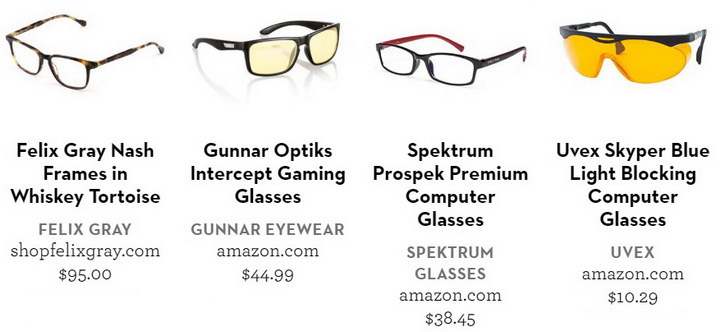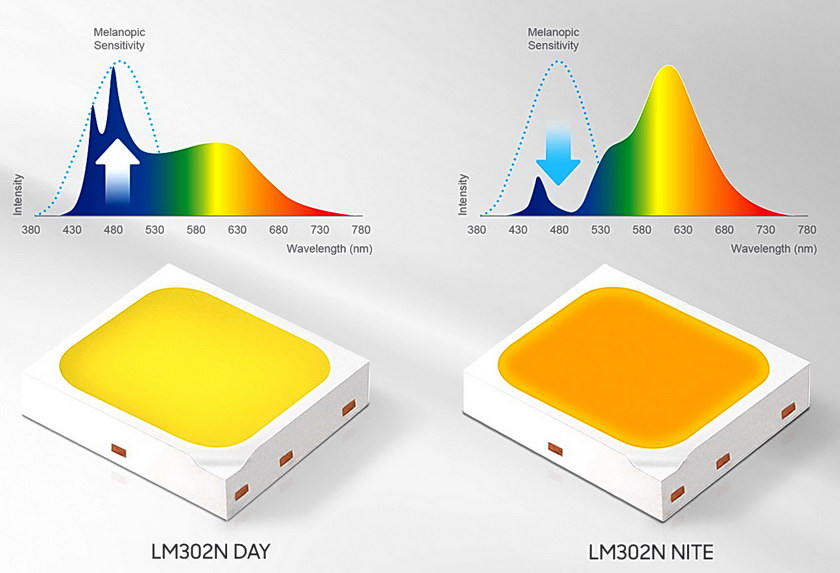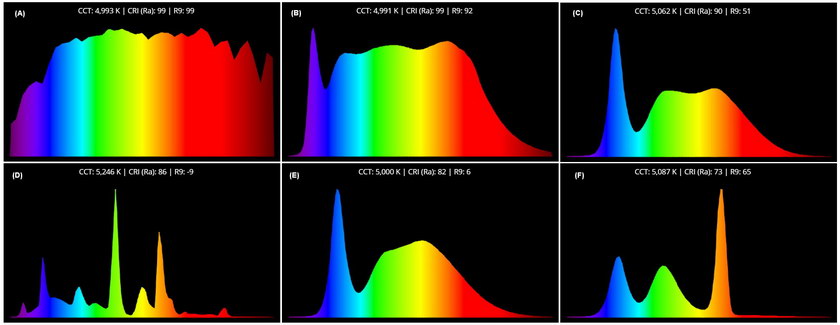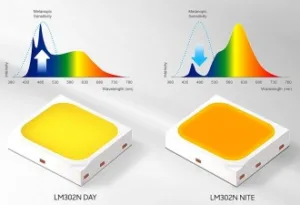In yesterday’s Display Daily, I discussed some of the science behind blue light, melatonin and circadian rhythm. In today’s DD, I will discuss some of the products display companies have introduced in response to the public’s interest in blue light and, especially, its effect on going to sleep at night. While the science of melatonin in relationship to displays isn’t really clear, reducing blue light from displays is something most display makers seem to be working on.

 Apple’s Dark Mode and Night Shift. (Credit: Apple)
Apple’s Dark Mode and Night Shift. (Credit: Apple)
Apple has introduced two features for iOS to reduce blue light exposure, Night Shift and Dark Mode. Night Shift was introduced with iOS 9.3 in 2017. This app reduces the color temperature of the screen, which in turn reduces the amount of blue light exposure. In Apple’s example in the image, they used a background with a lot of orange in it so to see the effect of Night Shift, look at the small white areas of the screen. The iOS default setting is for Night Shift to be turned on automatically from dusk till dawn, although the user can change the schedule or turn it off completely. D
ark Mode was included in the recently introduced iOS 13. Dark mode is what others might call “Reverse Video.” Most people have their computers, tablets and phones set up to look like paper with black text on a white background. Dark Mode uses white text on a black background. This reduces the total amount of light emitted from the screen when showing text, including the emitted blue light. For an OLED display, it also reduces the power consumed by the display. Dark Mode and Night Shift can be used together.
Samsung
On February 26th, Samsung issued a press release titled “Samsung Display Unveils OLED Display Optimized for 5G Era.” One reason I’m giving the complete title is because I’m not sure how the announcement relates to 5G but I guess “5G” catches more eyes than “melatonin.”
The announcement is for a new OLED display for smartphones, including 5G smartphones, with reduced blue light output. Samsung used the standards laboratory SGS and their logo program to evaluate this product, not TÜV Rheinland used by Eyesafe and Dell. This newly developed OLED display emits 6.5% blue light, significantly lower than the 7.5% level of the Samsung OLED smartphone panel released last year. Samsung Display noted that its OLED products also have about 70 percent less blue light emissions than most current LCD smartphone displays. There is a second advantage that smartphone users are actually more likely to notice and care about: the new display uses 1.3W compared to the old display’s 1.5W, as measured by UL, a 15% decrease that means longer battery life.
 Blue Light Glasses from several vendors.
Blue Light Glasses from several vendors.
If you want to reduce blue light in your life, not just while looking at your computer or smartphone, you might want to buy a set of blue light glasses. As far as I can tell, virtually every company that sells glasses has a blue light option, so you can go to your normal optometrist or drug store. Glasses that have a modest blue light reduction often have a blue-reflective thin film coating on the lens. Superficially, these lenses appear clear but if you examine them in reflected light, you can see the blue light that isn’t reaching your eyes. Lenses with a more serious reduction in blue light are tinted amber and the more amber, the less blue light reaches your eye. Just Google “Blue Light Glasses” and you will find page after page of sources.
One thing about displays that reduce blue light or reduce total light is that most light that reaches the eye doesn’t come from displays. It is the environmental ambient light, either from natural or artificial sources. Blue light glasses will reduce this light as well, not just light from display screens.
 Samsung LEDs with spectra designed for day and night use. (Credit: Samsung)
Samsung LEDs with spectra designed for day and night use. (Credit: Samsung)
An alternative, however, is to use ambient light sources deliberately made with reduced blue light. For example, Samsung introduced on March 11th the LM302N series of LEDs intended to be used in ambient illumination applications. These LEDs come in day versions with high blue light and night versions with low blue light.
If a manufacturer wants to make a switchable day/night system, he would need to include both types of LM302N. The day version is available with correlated color temperatures (CCT) from 3000K to 6500K and the night version is available with CCTs from 1800K to 4000K. Samsung claims a color rendering index (CRI) for all versions of the LM302N of only 80+, making them unsuitable for color-critical tasks.
 Spectral distribution of various white light sources with a CCT of 5000K. A) Natural (D50) daylight (CRI=99); B) Waveform Lighting’s Absolute Series full spectrum lamp (CRI=99); C) White LED that uses green and red phosphors (CRI=90); Florescent lamp (CRI=86); E) White LED using a yellow phosphor blend (CRI=82); White light from RGB LEDs (CRI=73) (Credit: Waveform Lighting)
Spectral distribution of various white light sources with a CCT of 5000K. A) Natural (D50) daylight (CRI=99); B) Waveform Lighting’s Absolute Series full spectrum lamp (CRI=99); C) White LED that uses green and red phosphors (CRI=90); Florescent lamp (CRI=86); E) White LED using a yellow phosphor blend (CRI=82); White light from RGB LEDs (CRI=73) (Credit: Waveform Lighting)
Seasonal affective disorder (SAD) plagues some people with depression in winter, especially in northern areas with short day length. One treatment for SAD is to sit for several hours under full spectrum light that simulates daylight. In some ways this is the opposite problem, with the opposite solution, compared to the melatonin issues I’ve talked about so far. Instead of reducing blue and green light, you treat SAD with light that simulates natural daylight, including daylight’s high levels of blue and green.
The figure shows the spectral distribution of the energy in various light sources. Waveform Lighting’s Absolute Series (B) has a spectrum very similar to D50 daylight (A). This is produced by a blue LED at 420nm, coupled with a mixture of blue, green and red phosphors. There are many vendors of full-spectrum lamps and this approach, blue LED and RGB phosphors is a common approach. All xenon lamps are also full-spectrum and florescent and metal halide lamps can be designed to be full spectrum by using the right fill materials.
One of the advantages of full spectrum light is it has a very high color rendering index (CRI). People like artists, designers and textile workers who are concerned with producing accurate colors for real objects use full spectrum, high CRI light even if they aren’t concerned about SAD. High CRI illumination is the real-world equivalent of a display with a carefully calibrated color gamut and color rendering algorithms: it allows you to reliably get the color you expect.
By the way, SAD may be a trendy problem but it is not new. It was first described by the 6th century Goth scholar Jordanes when he described the inhabitants of Scandza (Scandinavia). –Matthew Brennesholtz

